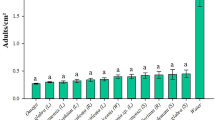Abstract
The potential ofTrichogramma evanescens Westwood andT. embryophagum Quednau to controlEphestia kuehniella andE. elutella was evaluated under laboratory conditions. BothTrichogramma species parasitised eggs of the twoEphestia spp. in bulk wheat at 1, 2 and 5 cm depth. The release ofT. evanescens was more effective than that ofT. embryophagum resulting in higher rates of parasitism, predation and parasitoid induced mortality. At 17‡C and 26‡C, the mortality ofEphestia due to the release ofT. evanescens was 67, 78% and ofT. embryophagum 27 and 38%, respectively. The difference in host finding efficiency between the two species was large, at 5 cm depth and 26‡C,T. evanescens parasitised about four times more host eggs compared to T.embryophagum.
Résumé
La capacité deT. evanescens et deT. embryophagum à contrÔlerEphestia spp. a été évaluée en conditions de laboratoire. Les deux espèces deTrichogramma arrivent à parasiter les ∄ufs d’Ephestiakuehniella et d’E.elutella dans le blé stocké, indifféremment à une profondeur de 1, 2 et 5 cm. L’espèceT. evanescens donne un meilleur résultat queT. embryophagum, avec un taux de parasitisme et une mortalité &Ephestia plus importants. A 17 ‡C et 26 ‡C, on a observé un taux de parasitisme avecT. evanescens de 67 % et 77,8 % respectivement, et seulement de 27 % et 38 % avecT. embryophagum, respectivement. On a montré que le choix des espèces les plus performantes parmi celles qui sont disponibles donne une perspective favorable pour l’amélioration du contrÔle des lépidoptères nuisibles aux produits stockés.
Similar content being viewed by others
References
Abbott, S. - 1925. A method of computing the effectiveness of an insecticide. -J. Econ. Entomol., 18, 265–267.
Biever, K. D. - 1972. Effect of temperatures on the rate of search byTrichogramma and its potential application in field releases. -Environ, Entomol., 1, 194–197.
Bin, F. & Vinson, S. B. - 1990. Efficacy assessment in egg parasitoids (Hymenoptera) proposal fora unified terminology. -Proceedings of San Antonio meeting on “Trichogramma and other egg parasitoids”, Sept. 23–27, 1990. Ed. INRA, Paris 1991, (les colloques n‡ 56), 175–179.
Brower, J. H.-1984.Trichogramma: potential new biological control method for stored-product-Lepidotera. -Proceedings of the Third International Working Conference on Stored-product Entomology, Manhattan, USA, October 23–28, Kansas State University Press, 726 p.
Brower, J. H. - 1988. Population supression of the Almond Moth and the Indianmeal Moth (Lepidoptera: Pyralidae) by release ofTrichogramma pretiosum (Hymenoptera: Trichogrammatidae) into simulated peanut storages. -J. Econ. Ent., 81, 944–948.
Brower, J. H. - 1990. Host locating ability ofTrichogramma pretiosum Riley (Hymenoptera: Trichogrammatidae) in inshell peanuts under laboratory conditions. -J. Agric. Entomol., 7, 265–273.
Hase, A. - 1922. Biologie der Schlupfwespe (Habrobracon brevicornis Wesmael (Braconidae)). Zugleich ein Beitrag zur Frage der biologischen BekÄmpftung von Schadinsekten. -Arb. Biol. Reichsanst. Land. Forstw., 11, 95–168.
Hase, A. - 1925. Weitere BeitrÄge zur Frage der biologischen BekÄmpfung von Schadinsekten, insbesondere über die BekÄmpfung der Mehlmotten mit Hilfe von Schlupfwespen. -Arb. Biol. Reichsanst. Land. Forstw., 14, 51–78.
Hassan, S. A. &Guo, M. F. - 1991. Selection of effective strains of egg parasites of the genusTrichogramma (Hym., Trichogrammatidae) to control the european corn borerOstrinia nubilalis Hb. (Lep., Pyralidae). -J. Appl. Entomol., 111, 335–341.
Lewis, W. J., Jones, R. L. &Sparks, A. N. - 1972. A host-seeking stimulant for the egg parasite,Trichogramma evanescens: its source and a demonstration of its laboratory and field activity.-Ann. EntomoL Soc. Am., 65, 1087–1089.
Press, J. W. - 1992. Comparative penetration efficacy in wheat between the weevil parasitoidsAnisopteromalus calandrae and Chaetospila elegans (Hymenoptera: Pteromalidae). -J. Ent. Sci., 27, 154–157.
Press, J. W., Cline, L. D. &Flaherty B. R. - 1982. A comparison of two parasitoids,Bracon hebetor (Hymenoptera: Braconidae) andVenturia canescens (Hymenoptera: Ichneumonidae), and a predatorXylocoris flavipes (Hemiptera: Anthocoridae) in supressing residual populations of the almond moth,Ephestia cautella (Lepidoptera,: Pyralidae). -J. Kans. Ent. Soc, 55, 725–728.
Prozell, S., Wiedenmann, G. & Hassan, S. A. - 1994. The egg parasitoidT. evanescens as a potential biological control agent against the Indian Meal MothPlodia interpunctella. -Proceed-ings of Cairo meeting on “Trichogramma and other egg parasitoids”, Oct. 4–7 , 1994. Ed. INRA , Paris 1995 , (les colloques n‡ 73), 131–132.
Quednau, W. - 1958. Über einige Orientierungsweisen des EiparasitenTrichogramma (Hym. Chalcididae) auf Grund von Lichtund Schwerereizen.-Anzeiger für SchÄdlingskunde, Pflanzens-chutz, Umweltschutz, 6, 83–85.
Quednau, W. - 1959. Über eine Methode zur Messung von Biozönose-Einflüssen unter Verwendung von Eiparasiten der GattungTrichogramma (Hym. Chalcididae).-Ztschr. Pfl. krankh. Pfl. schutz, 66, 77–86.
Reichmuth, Ch., Schmidt, H.-U., Levinson, A. R. &Levinson, H. Z. - 1979. Das jahreszeitliche Auftreten von Speichermotten (Ephestia elutella Hbn.) in Berliner GetreideschüttbodenlÄgern sowie der zeitentsprechende Einsatz von BekÄmprungsma\nahmen.-Z. angew. Ent., 25, 104–111.
Schöller, M. &Reichmuth, Ch. - 1994. Lagetiefe der Eier der Speichermotte,Ephestia elutella Hübner, und der Mehlmotte,Ephestia kuehniella Zeller (Lepidoptera: Pyralidae), in geschüttetem Weizen und Roggen. -Mitteilungen aus der Biologischen Bundesanstalf für Landund Forstwirtschaft, H. 301, 201.
Schöller, M., Reichmuth, C. & Hassan, S. A. - 1994. Studies on biological control ofEphestia kuehniella Zeller (Lep.: Pyralidae) withTrichogramma evanescens Westwood (Hym.: Trichogrammatidae)-host-finding ability in wheat under laboratory conditions.-In: Proceedings of the 6th International Working Conference on Stored-product Protection,Highley, E., Wright, E. J., Banks, H. J. and Champ, B. R. (eds.). 17–23 April 1994, Canberra, Australia, Volume2, 1142–1146.
Wührer, B. G. &Hassan, S. A. - 1993. Selection of effective species/strains ofTrichogramma (Hym., Trichogrammatidae) to control the diamondback mothPlutella xylostella L. (Lep., Plutellidae).-J. Appl. Ent. 116, 80–89.
Author information
Authors and Affiliations
Rights and permissions
About this article
Cite this article
Schöller, M., Hassan, S.A. & Reichmuth, C. Efficacy Assessment Of Trichogramma Evanescens And T. Embryophagum ( Bdhym.: Trichogrammatidae), For Control Of Stored Products Moth Pests In Bulk Wheat. Entomophaga 41, 125–132 (1996). https://doi.org/10.1007/BF02893299
Received:
Accepted:
Issue Date:
DOI: https://doi.org/10.1007/BF02893299




